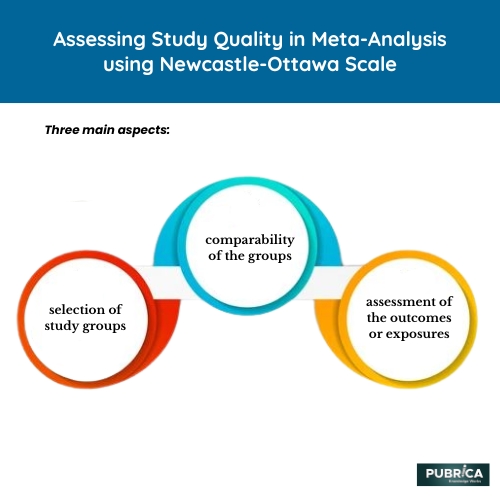
A critical review of Meta-Analysis conducted in this paper, “Physical activity and risk of breast cancer, colon cancer, diabetes, ischemic heart disease.
May 23, 2023
What are limitations on creating case reports using prospective cohort studies?
May 31, 2023Introduction
The Newcastle-Ottawa Scale (NOS) is a widely used tool for evaluating the quality of non-randomized studies, such as cohort and case-control studies, included in systematic reviews. The NOS assesses the quality of a study based on three main aspects: selection of study groups, comparability of the groups, and assessment of the outcomes or exposures.

- Selection: a) Representativeness of the exposed cohort: Is the exposed cohort truly representative of the average population exposed to the risk factor under investigation? b) Selection of the non-exposed cohort: Is the non-exposed cohort drawn from the same population as the exposed cohort? c) Ascertainment of exposure: How is the exposure assessed and documented? Is it through a secure record, structured interview, or self-report? d) Demonstration that the outcome of interest was not present at the start of the study: Does the study confirm that the outcome was not present in the participants at the beginning of the study?
- Comparability: a) Comparability of the cohorts on the basis of the design or analysis: Are the cohorts comparable, and are the study groups controlled for important confounding factors?
- Outcome: a) Assessment of outcome: How is the outcome assessed and documented? Is it through independent blind assessment, record linkage, or self-report? b) Was follow-up long enough for outcomes to occur: Was the duration of follow-up sufficient for the outcomes of interest to occur? c) Adequacy of follow-up of cohorts: What proportion of the cohorts were followed up? Was the follow-up rate high enough to minimize potential bias?
Each of these criteria is awarded a star if the study meets the specific criterion, with a maximum of nine stars in total. The NOS does not provide strict cutoffs for study quality, but higher scores generally indicate higher quality. Systematic reviewers can use the NOS scores to identify high-quality studies for inclusion in their reviews or conduct sensitivity analyses to assess the impact of study quality on the overall results.
Keep in mind that the NOS is just one of several tools available for assessing the quality of non-randomized studies. Depending on the specific study design and research question, other tools, such as the Risk of Bias In Non-randomized Studies of Interventions (ROBINS-I) tool, may be more appropriate.
Conclusion
A systematic review manuscript earns the adjective systematic if it is based on a clearly formulated question, identifies relevant studies, appraises their quality and summarizes the evidence using the explicit methodology. The explicit and systematic approach distinguishes systematic reviews from traditional reviews and commentaries. Whenever we use the term review in this blog, it will mean a systematic review. Reviews should never be done in any other way.
About Pubrica
Pubrica’s research and writing teams deliver scientific and medical research articles that writers and practitioners may find valuable. Pubrica medical writers help you create and rewrite the introduction by telling the reader about the chosen research subject’s limitations. Our specialists comprehend the order in which the restricted subject, difficulty, and background are followed by the targeted region in which the hypothesis is offered.
